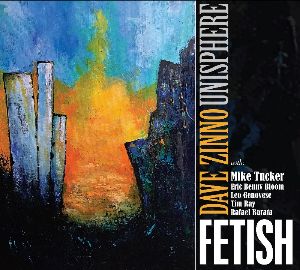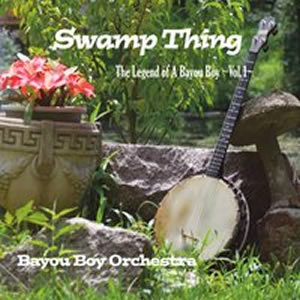 Dave Zinno Unisphere is a good name for Zinno’s adept combo. Unisphere implies unity in a big way, and that is what Zinno and his men can bring all sorts of energy and urgency to their particular brand of jazz. Colors and tones are created uptempo in a way that makes a listener imagine an explosion of images. Their new Fetish album shows how each player swings into action and taps out numbers that are bursting with life.
Dave Zinno Unisphere is a good name for Zinno’s adept combo. Unisphere implies unity in a big way, and that is what Zinno and his men can bring all sorts of energy and urgency to their particular brand of jazz. Colors and tones are created uptempo in a way that makes a listener imagine an explosion of images. Their new Fetish album shows how each player swings into action and taps out numbers that are bursting with life.
Zinno opens his own album with a run of thick, knobby low end notes on title track “Fetish.” His torrid, rippling notes, swiftly joined by a racing horn, bucking keys, provides a neurotic nerve center for a tense of exchange of instrumentation and suspenseful drumming. The entire opening track conjures images of someone being chased through city streets in an old noir classic. Saxophones blare in urgent need while drum fills open up another set of motion. All of these fast moving parts find their center in that Zinno method of unfurling rapid motion low end.
A lower temperature piece, “Out Of The Hole,” by Leo Genovese sways across the aural landscape with a brilliant mix of wide, swaying horn and elegant piano. With a feeling between 1950s hard jazz and a piano bar vibe, this piece feels open and free and classy at once. Mike Tucker’s tenor sax moves like a gazelle, traveling the uphill and downhill motions of the Rafael Barata drums and Zinno groove like a creature of natural motion. Fortunately, this piece is long enough at 7:39 minutes to let all of these exciting elements breathe and let themselves workout their own special place along this road of colorful musicianship.
“Unknown Mystery” contributed by trumpet and flugelhorn player Eric Benny Bloom moves about like a thief in the night, cautious, quiet, a presence felt more than seen. Bass notes sink ever lower in pitch and tone, suggesting mischief is afoot. Above that tricky footwork is an electric keyboard buzzing its loose melodic thrust all over the open spaces in this piece’s groove. Keyboardist Leo Genovese struts his stuff and gives this piece a modern slickness. Eventually, Bloom unfurls his magic on trumpet, offering a wider horn to contrast with the thinner tenor sax, and the contrast makes the listener appreciate all of the moving parts within this piece. A fantastic arrangement, this piece combines the suspicious groove with a surefooted saxophone line, indicating the prowler can put on one heck of a front. It also demonstrates how well this combo can use contrasting tones and flows to develop an engaging work.
An adventurous, action-packed horn line turns “The Golden Age” by Mike Tucker and Rafael Barata into a glowing tribute to a special times and place, like the era of hard bop. Mike Tucker’s saxophone is a driving force, a mellifluous line that moves with great freedom, taking many turns at will. Tim Ray’s racing brittle piano notes go toe to toe with Zinno’s plumb low end moves and tones. It is the way everything in this piece spins around everything else in this piece that makes it a whirling dervish of excitement, like a page turning novel one cannot put down until the end.
“So Close So Far” is a more temperate number than the high flying, hard charging numbers on this album. Tim Ray’s gentle patter of piano notes walk hand in hand with Mike Tucker s’ easygoing melodic line. Here, the combo focuses on assembling mellow instrumental lines into an intricate passage. Zinno’s thick as wood low end notes seem to be coaxing more out of the tenor sax, inspiring the sax to sail higher and move more breezily through the sonic landscape.
Composed by Brazilian musician Edu Lobe and arranged for this album by Tim Ray, “Beatriz” weeps its mournful lament of loss, sorrow, and remembrance. A bluesy moan of horns amounts to a sad day of introspection. Melancholy piano notes fall like rain over a quiet run of gentle low end notes, emulating the moral support of one who understands. The players succeed in creating a strong emotive content to this number.
Zinno’s dark low bass notes rumble their way into the listener’s consciousness on Paul Nagel’s “Future History.” Over that low end run, piano notes cascade like a waterfall over a rocky wall, and, a saxophone begins a wide, soaring melodic line. Tim Ray continues to build an epic feeling with his careful considerate slaps of piano chords. Mike Tucker’s gushingly wide sax line moves with a majestic sweep over the knobby notes from the other players. Rafael Barata’s drum work includes hefty fills that helps with the heavy lifting beneath the upper registers. It all feels so large because each player is contributing much vitality and it all could be used in a science fiction film score because this “Future History” does reveal a glimpse into the mind of a composer with a new kind of musical vision.
“Melancholy Daydream” maintains itself with persistent piano chords supporting a loose, freewheeling saxophone line. While the piano and the rhythm section slowly build up into a more vibrant, intricate pattern, the saxophone becomes more effusive, spreading its emotive vibe in ever greater spirals. It is the contract between the rhythm section’s eventual spread with the saxophone’s looser prettiness that makes this piece successful. This bold contrast continues through different tempos, dynamics, and anything else that might change during this group’s in studio experimentation.
“Over The Horizon” is a breezy affair. Its saxophone line sways. Its piano line tinkles notes in a sophisticated line. With its airy saxophone lines and sprinkles of notes from the other instruments, this work creates a sense of a bird in flight, changing directions on a whim yet still ending up with the bird coming down in one swoop. That dance of flourishing instruments is what impresses the most here.
Rivulets of piano notes is one distinguishing feature of “Into The Whole.” The other instruments follow suit with a similar pattern, notes racing from one player until it is time for another to take over. This pattern plays itself out in many ways. A darting saxophone line becomes wider, more vibrant before letting the upright bass take over, letting loose its own hard but emotive low end lines. This piece makes it mark in the way each instrumentalist can interpret how to play out that quick succession of notes while knowing, on instinct, when to slip back into the ensemble support of the remainder of the band.
Easing its way into the listener’s consciousness with a psychedelic mix of colors and tones, “Nile” is one of those eerie mood pieces that can conjure all sorts of mystical imaginings. As exotic as its title, “Nile” moves to a slow current, emitting an air of mystery with its down tempo blend of instrumentation. Bits of hand percussion, a seductive saxophone line, and a gentle run of silky bass notes make this one an ear tug. One cannot help but to get caught up in its mysterious vibe.
Closing track “Meu Fraco e Cafe Forte” makes for a classy grand finale. Co-arranged by Rio trombonist/arranger Rafael Rocha and Rafael Barata based on a composition by Dom Salvador, every player struts his stuff here. From zippy horn lines that create multiple colors moving with lightning speed to a breezier horn that glides above the primary saxophone. A drum solo facilitates the many moving parts above and one can imagine the players using all the energy from the coffee in this piece’s title to inspire their urgent motions.
Zinno and his Unisphere have captured a lot of emotions on this Fetish album. Not only does it impress with its musical ideas and concepts. It is even more impressive that Zinno and the rest of the group have the dexterity of musicianship to have brought many of these ideas to life. Released by Whaling City Sound in New Bedford, Massachusetts and produced by Zinno, Tucker, and Steve Rizzo mostly at Stable Sound Studio in Portsmouth, Rhode Island, Fetish jumps out of the stereo speakers with astounding vibrancy on every track.

